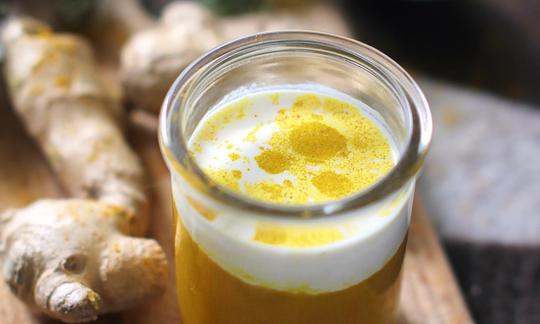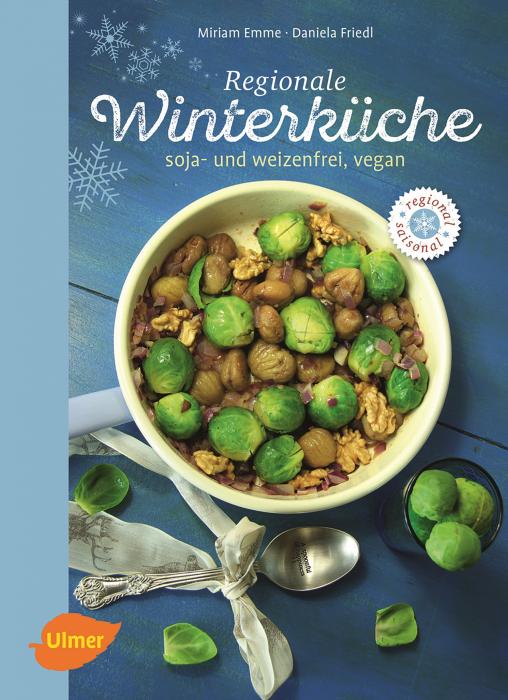Pumpkin Cappuccino Soup with Curry, Ginger, and Oat Cream
vegan
Ingredients (for servings, )
| For the pumpkin soup | |
|---|---|
| 11 oz | Hokkaido pumpkins (Hokkaido pumpkins) |
| ⅔ oz | Ginger, raw (organic?) |
| 2 | Shallots, raw (organic?) (1.4 oz) |
| 1 tbsp | Sunflower oil (cold pressed? raw? organic?) (0.48 oz) |
| 1 tbsp | Curry powder (organic?, raw?) (0.22 oz) |
| 500 ml | Vegetable broth with little salt (organic?) (17 oz) |
| 1 dash | Table salt (table salt, raw?, organic?) (0.01 oz) |
| 1 dash | Black pepper (organic?, raw?) (0.00 oz) |
| 1 | Limes, raw (organic?) (2.4 oz) |
| For the oat foam | |
| 250 ml | Oat cream, oat cuisine, oat cream (raw?, organic?) (8.9 oz) |
Equipment
- hand-held blender / immersion blender or blender
- stove
- citrus juicer (lemon squeezer)
- saucepan
Type of preparation
- cook
- sauté
- squeeze
- season to taste
- beat
- purée
- deglaze
- remove the skin
Preparation
For the pumpkin soup
Wash and clean the pumpkin and cut into small cubes. You do not need to peel Hokkaido pumpkins.Peel the ginger and shallots and cut into thin slices.
Heat the oil in a saucepan and sauté the pumpkin cubes, ginger, and shallots.
Sprinkle the curry powder on top and deglaze with the vegetable broth. Let the mixture simmer gently for about 20 minutes.
Squeeze the lime carefully and then finely purée the soup and season with the salt, pepper, and lime juice.
For the oat foam
Put the oat cream into a small saucepan and heat (do not let it boil). Use an immersion blender and beat until foamy.Serving
Divide the pumpkin soup into cups, top with the oat foam, and sprinkle with curry powder. Serve hot.
|
Nutritional Information per person
Convert per 100g
|
2000 kcal | |
|---|---|---|
| Energy | 283 kcal | 14.2% |
| Fat/Lipids | 17 g | 24.8% |
| Saturated Fats | 1.6 g | 7.9% |
| Carbohydrates (inc.dietary fiber) | 34 g | 12.7% |
| Sugars | 14 g | 15.4% |
| Fiber | 6.4 g | 25.4% |
| Protein/Albumin | 3.2 g | 6.4% |
| Cooking Salt (Na:736.4 mg) | 1'870 mg | 77.9% |
| Essential micronutrients with the highest proportions | per person | 2000 kcal | |
|---|---|---|---|
| Sodium, Na | 736 mg | 92.0% | |
| Fat | Linoleic acid; LA; 18:2 omega-6 | 5.4 g | 54.0% |
| Min | Manganese, Mn | 0.98 mg | 49.0% |
| Elem | Potassium, K | 755 mg | 38.0% |
| Vit | Vitamin C (ascorbic acid) | 30 mg | 38.0% |
| Vit | Vitamin E, as a-TEs | 4.5 mg | 38.0% |
| Vit | Vitamin B6 (pyridoxine) | 0.46 mg | 33.0% |
| Vit | Vitamin A, as RAE | 258 µg | 32.0% |
| Vit | Vitamin B9, B11 (Folate, as the active form of folic acid) | 48 µg | 24.0% |
| Prot | Tryptophan (Trp, W) | 0.06 g | 22.0% |
Detailed Nutritional Information per Person for this Recipe
The majority of the nutritional information comes from the USDA (US Department of Agriculture). This means that the information for natural products is often incomplete or only given within broader categories, whereas in most cases products made from these have more complete information displayed.
If we take flaxseed, for example, the important essential amino acid ALA (omega-3) is only included in an overarching category whereas for flaxseed oil ALA is listed specifically. In time, we will be able to change this, but it will require a lot of work. An “i” appears behind ingredients that have been adjusted and an explanation appears when you hover over this symbol.
For Erb Muesli, the original calculations resulted in 48 % of the daily requirement of ALA — but with the correction, we see that the muesli actually covers >100 % of the necessary recommendation for the omega-3 fatty acid ALA. Our goal is to eventually be able to compare the nutritional value of our recipes with those that are used in conventional western lifestyles.
| Essential fatty acids | per person | 2000 kcal |
|---|---|---|
| Linoleic acid; LA; 18:2 omega-6 | 5.4 g | 54.0% |
| Alpha-Linolenic acid; ALA; 18:3 omega-3 | 0.08 g | 4.0% |
| Essential amino acids | per person | 2000 kcal |
|---|---|---|
| Tryptophan (Trp, W) | 0.06 g | 22.0% |
| Threonine (Thr, T, irreversibly transaminated) | 0.12 g | 13.0% |
| Isoleucine (Ile, I) | 0.16 g | 13.0% |
| Valin (Val, V) | 0.19 g | 12.0% |
| Phenylalanine (Phe, F) | 0.16 g | 11.0% |
| Leucine (Leu, L) | 0.24 g | 10.0% |
| Lysine (Lys, K, irreversibly transaminated) | 0.17 g | 9.0% |
| Methionine (Met, M) | 0.05 g | 6.0% |
| Vitamins | per person | 2000 kcal |
|---|---|---|
| Vitamin C (ascorbic acid) | 30 mg | 38.0% |
| Vitamin E, as a-TEs | 4.5 mg | 38.0% |
| Vitamin B6 (pyridoxine) | 0.46 mg | 33.0% |
| Vitamin A, as RAE | 258 µg | 32.0% |
| Vitamin B9, B11 (Folate, as the active form of folic acid) | 48 µg | 24.0% |
| Vitamin B1 (Thiamine) | 0.20 mg | 18.0% |
| Vitamin K | 13 µg | 17.0% |
| Vitamin B5 (Pantothenic acid) | 0.59 mg | 10.0% |
| Vitamin B3 (Niacin) | 1.4 mg | 9.0% |
| Vitamin B2 (Riboflavin) | 0.11 mg | 8.0% |
| Vitamin B7 (Biotin, ex vitamin H) | 1.8 µg | 4.0% |
| Essential macroelements (macronutrients) | per person | 2000 kcal |
|---|---|---|
| Sodium, Na | 736 mg | 92.0% |
| Potassium, K | 755 mg | 38.0% |
| Magnesium, Mg | 59 mg | 16.0% |
| Phosphorus, P | 115 mg | 16.0% |
| Calcium, Ca | 98 mg | 12.0% |
| Essential trace elements (micronutrients) | per person | 2000 kcal |
|---|---|---|
| Manganese, Mn | 0.98 mg | 49.0% |
| Copper, Cu | 0.21 mg | 21.0% |
| Iron, Fe | 2.7 mg | 20.0% |
| Zinc, Zn | 1.1 mg | 11.0% |
| Selenium, Se | 2.3 µg | 4.0% |
| Iod, I (Jod, J) | 4.4 µg | 3.0% |
| Fluorine, F | 0.02 µg | < 0.1% |
In "Regional Winter Cuisine" by Miriam Emme and Daniela Friedl, you can learn how vegan, soy- and wheat-free, yet creative dishes can be fun even in winter.
Since this book is written in German, a description is omitted here. If you are interested, please switch to German in the menu.
Just for the cold season, this pumpkin soup with curry, ginger, and oat cream is a delicious, light, and healthy dish with a touch of the exotic.
Hokkaido pumpkins: Unlike most other pumpkins, the skin of a small Hokkaido pumpkin (1–2 kg) can be eaten and doesn’t need to be peeled. This is because it softens when it is cooked. Hokkaido pumpkin has a firm consistency, is low in fiber, and has a slightly nutty flavor. The orange color comes from the large amount of beta-carotene it contains, which our body can convert into vitamin A. It also has large amounts of vitamin B1, B2, and B6; vitamins C and E; as well as folic acid, magnesium, iron, and phosphorus.
Oat cream: Oat cream or oat cooking cream is a healthy, light, vegan alternative to conventional cream. Oats have a high protein content and many essential amino acids. They are also rich in vitamins and minerals.
Ginger: Ginger is aromatic and has a pungent, spicy taste because it contains gingerol, a substance which has anticarcinogenic and anti-inflammatory effects. Thanks to borneol and cineol, ginger promotes digestion, calms the stomach, is effective against vomiting and nausea, and stimulates the appetite and circulatory system. As a cooking ingredient, ginger root is used in several forms including fresh, dried, and ground. Ginger roots that are harvested early are called young ginger or “green ginger,” and are milder in taste and not so woody.
Curry: Curry is understood to mean various spicy, stew-like dishes, but also curry powder, which is used here as an ingredient. Curry powder is a spice mix made up of about 13 different spices, whereby these mixes can vary widely. However, some ingredients are always included. Spices such as such as turmeric, which gives the spice its characteristic yellow color, and also coriander, cumin, black pepper, and fenugreek seeds are responsible for its typical flavor and are therefore found in most every mixture.
Making oat cream yourself: You can easily make your own oat cream at home. For this, you will need 1 part of rolled oats (e.g., 100 grams) to every 5 parts of water (500 grams), 1 tbsp of vegetable oil (nut oil tastes good), and a pinch of salt. Place the rolled oats, salt, and about half of the warm water in a bowl and let stand for about 5 minutes. Knead the thickened mixture, gradually add the remaining water, and then add the oil. Mix well. Let stand for an additional 10 minutes and then pass through a fine sieve. Afterwards, you can filter the cream through a cotton or gauze cloth to separate any remaining solid residues from the liquid. Oat cream can be kept in a sealed jar in the refrigerator for up to 6 days.
Leaving out extra salt: We have left the amount of salt the same as it is listed in the original recipe. The recipe itself, however, still has a very high salt content even if you use low-salt vegetable broth. If you wish, you can do without the additional pinch of salt.
Far Eastern variation: If you would like to have a bit more of an exotic taste that is no less delicious, you can use coconut milk instead of the oat cream. Chilli peppers, in the form of fresh peppers or red pepper flakes, are a nice addition to this dish.




